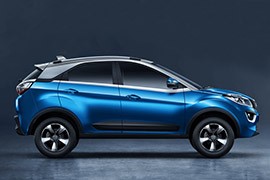TATA MOTORS Nexon Models/Series Timeline, Specifications & Photos
First production year: 2017
Engines: Gasoline, Diesel
Body style: SUV (Sports Utility Vehicle)
Tata introduced the Nexon as its first subcompact crossover in 2017, trying to get a slice of the growing SUV segment of the Indian market.
The Indian automaker pushed hard to accelerate the development of its cars, and the Nexon was the first vehicle to be built on top of a newly developed platform known as the Tata X1. Thanks to its higher ground clearance and the off-road-inspired design details, it quickly gained popularity in the Indian market. Later, in 2020 and 2023, the car was refreshed and improved to meet the stringent Bharat 6 emission standards, which were similar to the Euro 6 ones.
At the front, the Nexon featured a set of organic-shaped headlights, swept back and featuring LED lamps. The automaker installed the black and broad grille between them where the T-badge took center stage. It was underlined by a broad chromed trim spread from side to side. Lower, on the bumper, Tata placed the fog lamps in individual clusters fitted with chromed and black trims. On the lower side, in the apron, the automaker added a black air intake that helped cool the engine.
From its profile, the ascending beltline of the vehicle created a strong image for this subcompact crossover. The enlarged front and rear fenders, the sculptured doors, and the black plastic molds from the sides created an SUV stance that tried to convince customers it was an excellent choice for bad roads. Tata offered customers the option for a two-paint bodywork with a contrasting roof. Still, the door handles and mirror caps kept the main body color.
Inside, the Nexon surprised its customers with a modern-looking interior design. Atop the center stack, the automaker placed a touchscreen in a free-floating position. Underneath it, Tata installed the controls for the HVAC and the sound system. Fronting the driver was a clean-looking instrument cluster filled with two large dials for the speedometer and tachometer, which also contained smaller gauges at their lower area and flanked a TFT for the onboard computer. Between the front seats, the automaker placed a narrow center console that housed the gear stick, the rotary dial for driving modes, and a few storage areas. There was also an iPod connection and a USB port at the bottom of the center stack. In the back, the automaker added a split-folding bench where up to three passengers could sit.
Under the hood, Tata installed a choice of diesel and gasoline engines, either developed by itself or together with the Austrian specialist AVL. The base, 1.2-liter, turbocharged inline-three, produced up to 110 PS (109 hp) and was paired as standard with a six-speed manual gearbox. On the other hand, the turbo-diesel provided the same power from its inline-four configuration and with a larger displacement. Both versions were available exclusively as two-wheel drive affairs.
